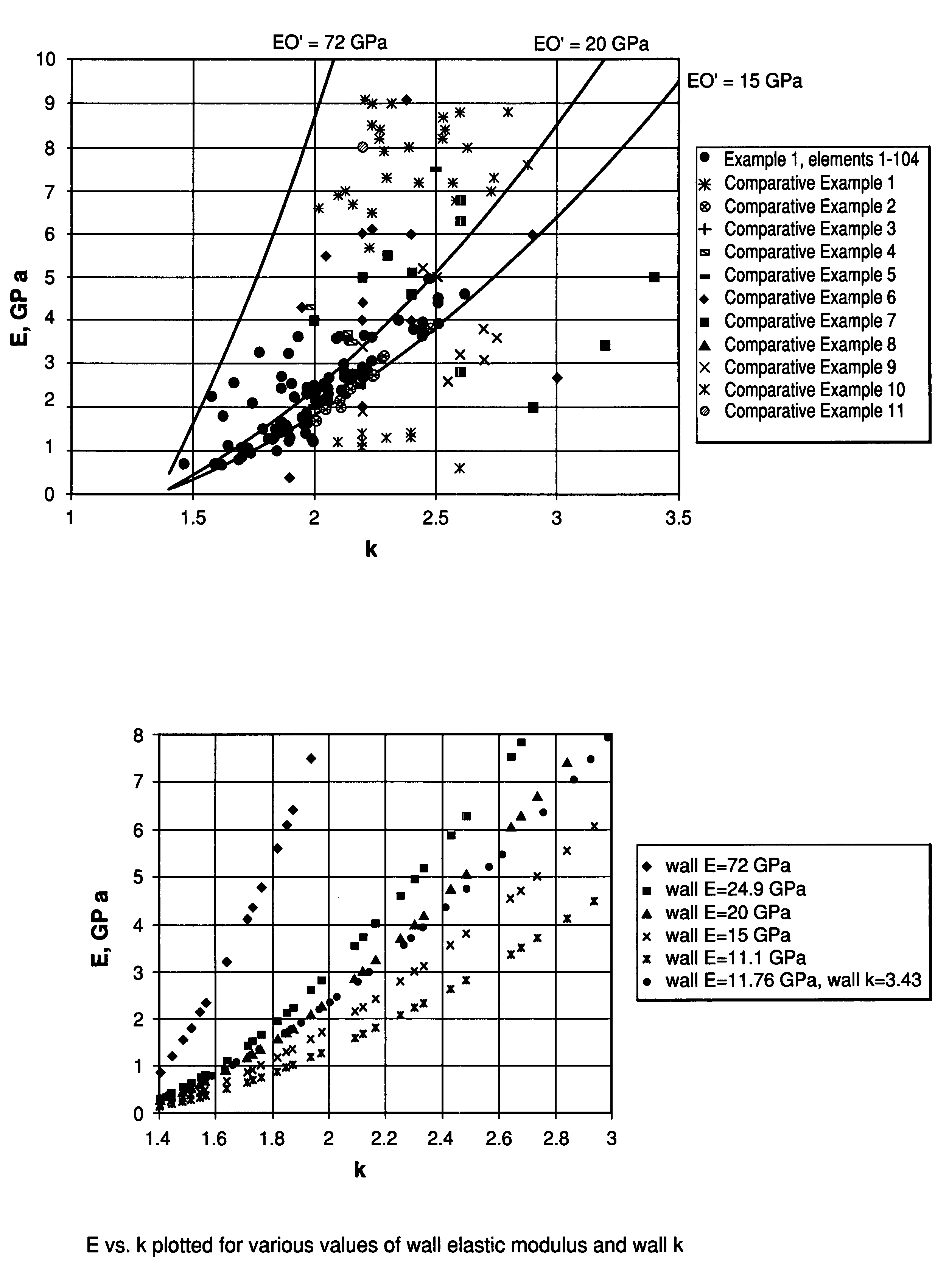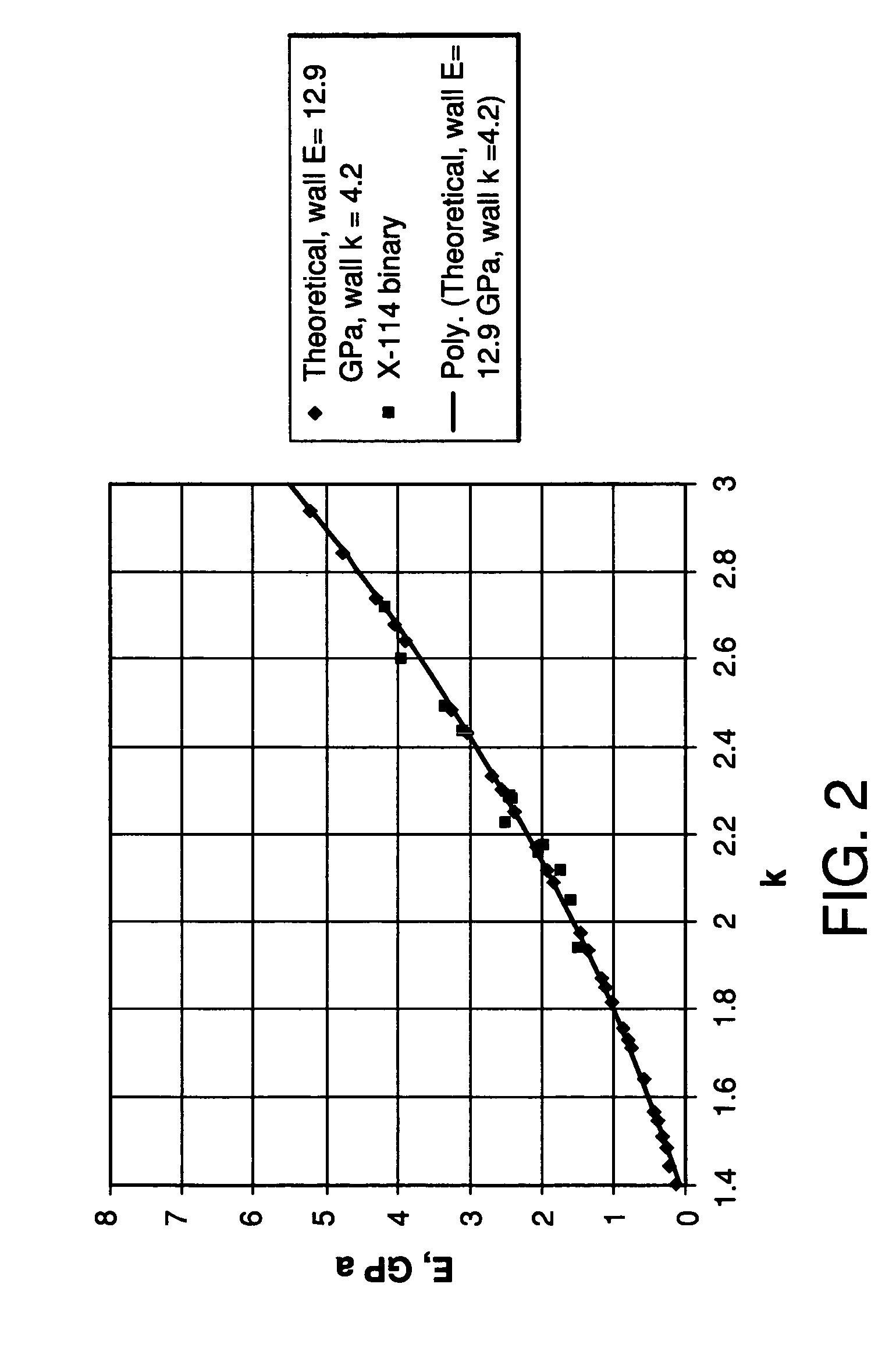Low dielectric materials and methods for making same
a technology of low dielectric materials and methods, applied in the field of materials, can solve the problems of difficult identification of improved low dielectric compositions, difficult to use these low dielectric compositions, and cracking or delamination
- Summary
- Abstract
- Description
- Claims
- Application Information
AI Technical Summary
Benefits of technology
Problems solved by technology
Method used
Image
Examples
example 1 – 14
Example 1–14
Selected Array Elements as Compartive Examples to Spun Coated Films
[0120]Sample films were prepared in the same manner as the general process for preparing array elements. The volume of each reagent dispensed into individual microtiter wells is provided in Table II. The solutions were dispensed, agitated, and calcined as in the general procedure to prepare array elements to films. The properties of each film are provided in Table III.
[0121]
TABLE IICOMPOSITION OF ARRAY ELEMENTS4:1 VolumeNitricHydrophilicHydrophobicSolvent:SurfactantWaterAcidTMAHEx.Source (μl)Source (μl)Ratio (μl)Solvent (μl)(μl)(μl)(μl)1138.2144.4 MTES329.9 PGMEA:L101573.2 PGMEA0.0247.2 0.1 M5TEOS2.4 wt. %2121.0126.2177.2207.50.0119.9 0.1 M5TEOSMTESpentanol:X114;pentanol;2.4 wt. %204.7261.8 PGMEAPGMEA:X114368.571.5163.4 PGPE:L101274.8 PGPE93.726.3 0.025 M5TEOSMTES1.2 wt. %468.571.5163.4 PGPE:L101274.8 PGPE58.761.2 0.2 M5TEOSMTES1.2 wt. %549.661.0189.3 PGPE:X114270.6 PGPE26.829.7 0.2 M5TEOSMTES; 9.71.2 wt....
example 15
[0123]A mixture was prepared containing 317.9 μl of TEOS and 326.3 μl of MTAS. A quantity of 635.7 μl of a 4:1 volume ratio of PGPE: Triton X-45 and 2027.3 μl of PGMEA was added to the mixture. Next, additional reagents were added to the mixture in the following order: 390 μl of water, 119.6 μl of 0.025 M HNO3, and 22.8 l of 1.2 wt. % TMAH in water. After the addition of water the mixture was aged at room temperature for 5 minutes. The subsequent addition of HNO3 and TMAH were also followed by individual 5 minutes aging steps. Once all of the reagents have been added, the entire solution is aged for 5 minutes at room temperature and agitated for 2–3 minutes to thoroughly mix the solution. The resulting clear solution was then aged for 1–24 hours at room temperature prior to spin coating.
[0124]The sol was dispensed onto a low resistivity P type Si wafer spinning at 500 rpm for 7 seconds and then accelerated to 1800 rpm for 35–40 seconds. The film formed during the spin c...
examples 16 – 27
Examples 16–27
[0127]Sample films were prepared in the same manner as Example 15 except that the types and / or amounts of silane sources, surfactant, solvent, and catalyst in the mixture were varied. These variations are provided in Table IV. The properties of each film are provided in Table V.
[0128]As Table V illustrates, under some conditions, materials with high E0′ were obtained at pHs greater than about 4 or using Si sources that generate acetic acid during hydrolysis and condensation.
[0129]Comparison of Tables III and V illustrate that compositions having relatively higher normalized wall elastic modulus, produced in an array format using alternative evaporative techniques, such as an orbital movement device, can be reproduced using conventional spin coating techniques.
Array Elements 28–131:
[0130]Sample films were prepared in the same manner as Example 1 except that the types and / or amounts of silica sources, surfactant, solvent, and catalyst in the mixture were varied. These va...
PUM
| Property | Measurement | Unit |
|---|---|---|
| wall elastic modulus | aaaaa | aaaaa |
| dielectric constant | aaaaa | aaaaa |
| temperature | aaaaa | aaaaa |
Abstract
Description
Claims
Application Information
 Login to View More
Login to View More - R&D
- Intellectual Property
- Life Sciences
- Materials
- Tech Scout
- Unparalleled Data Quality
- Higher Quality Content
- 60% Fewer Hallucinations
Browse by: Latest US Patents, China's latest patents, Technical Efficacy Thesaurus, Application Domain, Technology Topic, Popular Technical Reports.
© 2025 PatSnap. All rights reserved.Legal|Privacy policy|Modern Slavery Act Transparency Statement|Sitemap|About US| Contact US: help@patsnap.com



